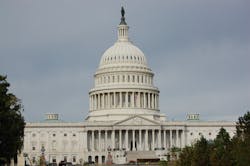With raising fuel taxes anathema to both political parties on Capitol Hill, experts believe the 114th Congress being formed in today’s election may rely on a “patchwork” of revenue-generating methods to restock the dwindling coffers of the highway trust fund (HTF).
“How to pay for transportation infrastructure is the 800 pound gorilla in the room,” James Burnley, who co-chairs the transportation practice at law firm Venable LLP in Washington D.C. and served as U.S. Secretary of Transportation from 1987 to 1989, told Fleet Owner.
“The funding challenge is just so daunting now at the federal level,” he explained, noting that the size of the fuel tax increase needed to cover expected HTF outlays would be too steep politically to bear.
Currently, the federal fuel tax on gasoline stands at 18.4 cents per gallon, while for diesel it is 24.4 cents per gallon – numbers a bipartisan group of Senators suggested increasing, to no avail, back in June.
“That’s why regardless of what happens in the election, a ‘patchwork’ of revenue solutions is most likely going to be used,” Burnley said.
“Speculating wildly, that’s most likely going to include some sort of indexing of the fuel tax to inflation, using funds generated from corporate tax reform efforts, and other methods,” he explained. “It’s just not likely there will be any stomach to double or triple fuel taxes.”
A range of groups – from the American Trucking Associations (ATA) to the American Society of Civil Engineers (ASCE) – believe increased levels of funding is needed to revitalized the U.S. roadway system, which is now a half-century old.
In a conference call with reporters last week, Dave Osiecki, ATA’s executive VP and chief of national advocacy, added that the HTF’s fiscal state remains perilous and is being propped up by infusions from the federal government’s general revenue fund.
“Since 2008, the government has transferred $55 billion into the HTF – and that’s up to over $65 billion now following the $10.8 billion transferred back in August,” he noted, with that infusion expected to run out May 31 next year.
Osiecki said that such general fund transfers are currently viewed on Capitol Hill as the “most favorable method” for keeping the HTF solvent.
That being said, a range of other methods are getting some political support, including:
- Indexing fuel taxes to inflation, the consumer price index (CPI), or some other economic metric;
- Switching to a wholesale fuel tax;
- Crafting an oil barrel tax;
- Redirecting leasing royalty payments from oil production on government lands to fund transportation needs;
- Redirecting some revenues gained from corporate tax reform for transportation needs, specifically from U.S. company profits repatriated from overseas operations.
About the Author
Sean Kilcarr
Editor in Chief
Sean Kilcarr is a former longtime FleetOwner senior editor who wrote for the publication from 2000 to 2018. He served as editor-in-chief from 2017 to 2018.
